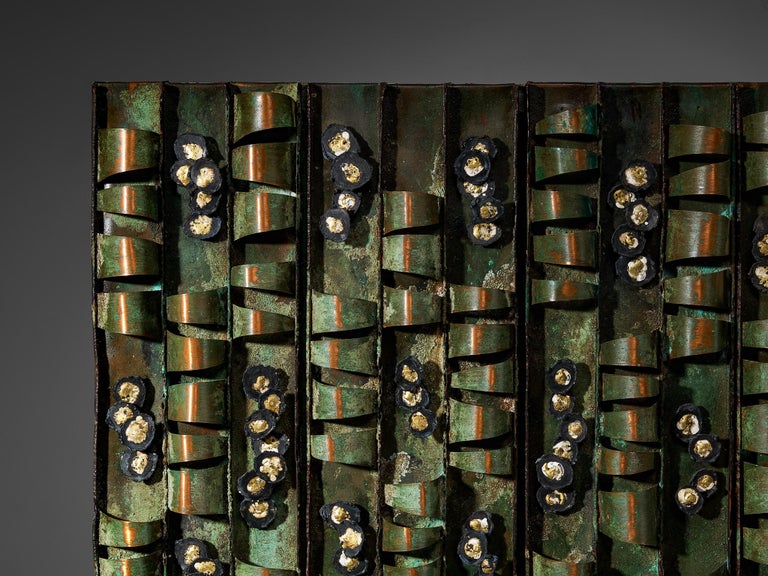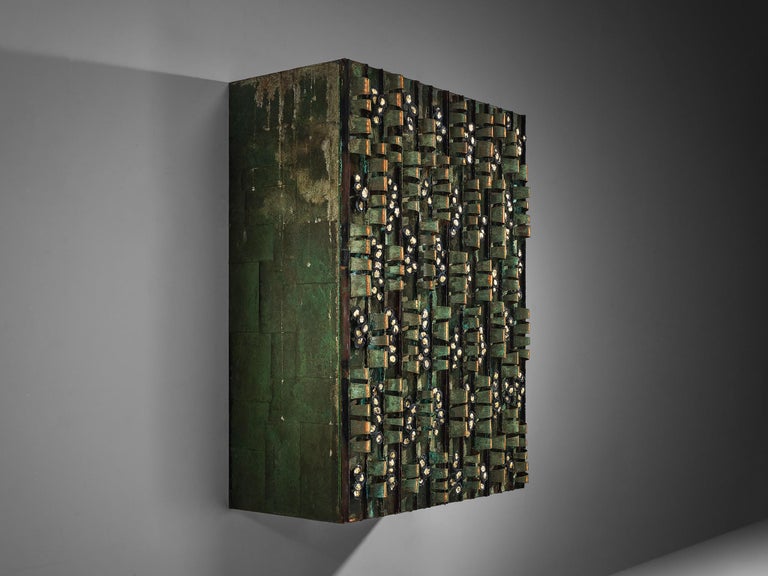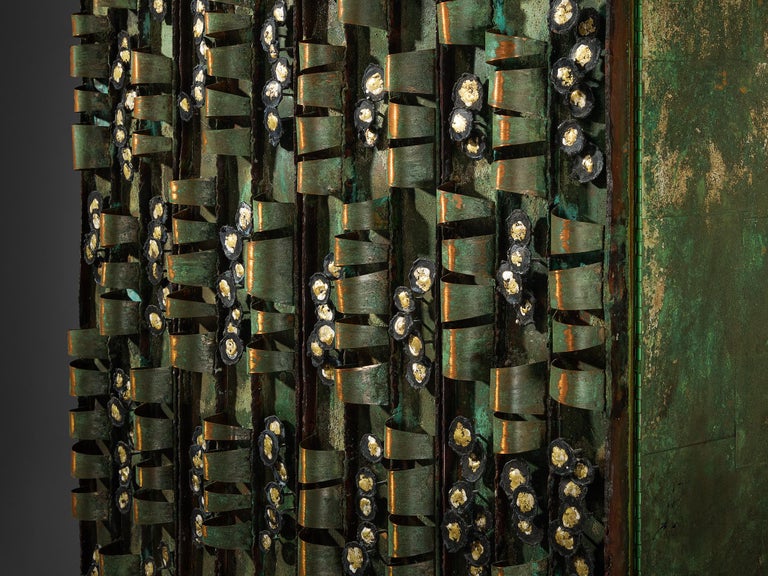










Paul Evans for Paul Evans Studio Early and Rare Loop Cabinet in Copper
Paul Evans for Paul Evans Studio, ‘Loop’ wall-mounted cabinet, welded copper with applied verdigris patina, steel, brass, painted wood, United States, circa 1968
Made around 1968, this Verdigris Copper Loop wall-mounted cabinet, also known as Loop, is an early design by Paul Evans and undeniably breathes artistic excellence combined with impeccable craftsmanship. The loop cabinet gained appraisal at the exhibition “Paul Evans: Crossing Boundaries and Crafting Modernism”, held in Michener Museum, Doylestown, Pennsylvania (1 March - 1 June 2014). In addition, the cabinet graced the walls of Dorsey Reading’s house, Evans’s most valuable collaborator. This piece exemplifies Evans’s idiosyncratic way with welding and constructing. Evans departed from the traditional values of the designer-craftsman, which prioritize respect for materials and functional simplicity. Instead, he showed a keen interest in manipulating materials and creating artificial aging effects. However, he maintained a strong belief in the importance of the craftsman's expertise and ingenuity as the foundation for innovation and replication. The emphasis on surface treatment became the defining characteristic of his furniture designs, of which this cabinet is a prime example. As Evans articulates the essence of his oeuvre, handmade product should bear the mark of the hand. Mere good lines are insufficient, as those can be industrially produced. Furniture ought to embody detail and richness.
The present Loop cabinet features bi-fold doors characterized by a sculptural relief comprising a series of looped screens in copper alternated by gold-colored studs arranged in a clustered way. To achieve this greenish-blue patina, Evans employed the verdigris technique. Copper comes into contact with air, water, and various elements, leading to oxidation and chemical interactions with its surroundings. The cabinet embodies an organic liveliness with beautiful color variations and natural-occurring shapes with an undulating outline.
Dorsey Reading, who started working as an apprentice for Paul Evans, and gradually evolved into Evans’s most relied-upon collaborator, helped building this cabinet. Reading’s career with Evans started out with washing the landscape pebbles that covered the floor of the showroom Evans and Phillip Lloyd Powell shared. From executing basic tasks to being a foreman, Reading played a pivotal role in the experimental nature of Evans' artistic endeavors for over 20 years. Reading played a crucial role in aiding Paul Evans to learn the practical aspects of metalworking, including cutting, welding, and shaping metal components, thereby realizing his furniture designs. The partnership between Evans and Reading was deeply symbiotic, characterized by mutual trust and understanding. Evans, with his visionary sketches, relied on Reading to translate concepts into tangible pieces, often employing coded symbols understood only by the two of them. Reading became largely responsible for the development and prototyping of products. Dorsey would build up the base structure, and Evans would direct all the additions and alterations. When Evans considered new techniques, Reading would do the research to explore and develop them further.
This truly exceptional piece of furniture with a remarkable provenance embodies Evans's distinctive approach to design, highlighting the plasticity of metal materials and resulting in handcrafted, labor-intensive pieces, each configured into its own distinct design.
Paul Evans (1931-1987) was among one of the most important American Studio Craft Movement members. Together with artists such as Wharton Esherick and George Nakashima, he helped to make the Philadelphia region a prominent center for the Studio Craft in the late 1960s. Born in Newton, Pennsylvania, Evans studied at a few different institutions such as the Philadelphia Textile Institute, the Rochester Institute of Technology, School for American Craftsman, and the Cranbrook Academy of Art. Eventually, he was drawn to New Hope, Pennsylvania, in 1955 where he collaborated and shared a showroom with Phillip Lloyd Powell until 1966. Powell’s woodwork and Evans's metal craftsmanship combined into a creative partnership. During this period, he started to create furniture with metal and sculpture by which he manipulated materials to achieve expressive surface effects. In 1964, Evans started working for the Directional Furniture company where he pursued a new phase of his career. Directional offered him new opportunities for selling his work throughout the US and he continuously introduced new lines. However, his line proved to be too expensive and by the end of the seventies, he ended his relationship with the company. It was also throughout the seventies that Evans started to replace these crusty, textured surfaced, that were patinated with paint and acid, with dazzling, reflective metal surfaces that were sometimes mixed with woods. Evans’s oeuvre has an impressive size especially when regarding all pieces were handmade. On March 6, 1987, the artist shut down his business and, unfortunately, died the next day due to a heart attack.
VAT within the EU: When buying or delivering an item within the EU, VAT usually applies and will be added.
Choose options











Product Details